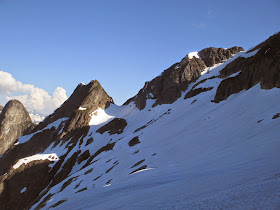This particular question is a moving target, and has three distinct parts. The first part concerns rope length on the glacier, the second part concerns rope type and the third part concerns the diameter of rope one might use.
Let's take a look:
Rope Length
There are several considerations that need to be addressed to determine rope length. How many people are going to be on the rope? Are there crevasses? If someone falls in, how do you intend to rescue them? Do you intend to pitch any portion of the climb?
First and foremost, we have to make sure that there is enough rope in the system to ensure that no two people are on the same snow bridge at once. Additionally, we need to make sure that there's enough distance so that if someone does fall in a crevasse, her partners have enough time to self-arrest before they get pulled into the hole.
A climber on a glacier.
Second, if the rope is shorter, it may be difficult to perform more than one type of crevasse rescue. We teach beginners the "Direct Haul" technique because it is the simplest and requires the least amount of rope. However, the Direct Haul, doesn't work if there are knots in the rope (used to help arrest the crevasse fall) and can be difficult if the rope is embedded deeply in the crevasse lip.
One can get away with a much shorter piece of rope if they intend to only perform a Direct Haul style rescue. However, if a climber wishes to perform any kind of Drop Loop system -- which takes a lot less muscle to perform due to better lip management -- they will need a lot more rescue rope, at least twice the amount out between individuals on either end. In other words, if there's 40-feet between two climbers on a two-person team, each climber will need at least 80-feet to complete a rescue, meaning that a two-person team would need a 60-meter rope. Bigger teams can get away with less, if they intend to perform a drop-loop.
Diameter and Rope Type
In recent years, there has been a push to use semi-static ropes on glaciers. The reason that one might want this is because dynamic ropes stretch, and if someone falls into a crevasse while tied to a dynamic rope the stretch might be great enough for the person to hit something, or for the person to get "corked" in the crevasse. The idea is that if you use one of these semi-static ropes, then he risk of hitting something or getting corked goes down.
Some might argue for dynamic ropes because they're afraid of how hard and fast the rope will stop them in the event of a fall. But the reality is that a rope team is commonly pulled a bit before the falling climber stops. This provides for a slower, less jarring hit.
Semi-static ropes can get really really thin. But for prussic-hitches to work, and for stopper butterfly knots (knots placed in the rope to arrest a fall in the lip of a crevasse) to work, the rope needs to be at least 8mm.
If you will be pitching, rock climbing, or ice climbing in any way, you should still use a dynamic single rope.
A half of a twin rope should never be used because it's designed to stretch in conjunction with a second rope. When alone, it will stretch dramatically, which could lead to a climber hitting something or getting corked.
Choosing the right rope is a much easier skill than many others in climbing. It just takes a little practice...!
--Jason D. Martin



























